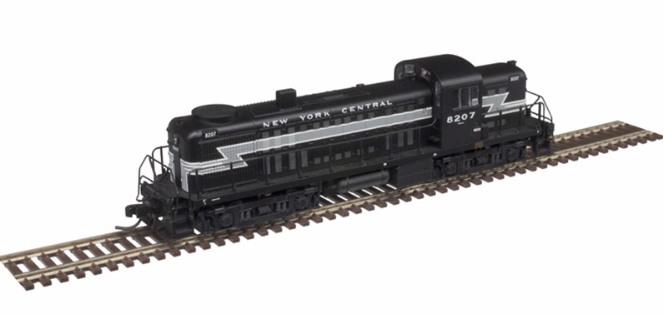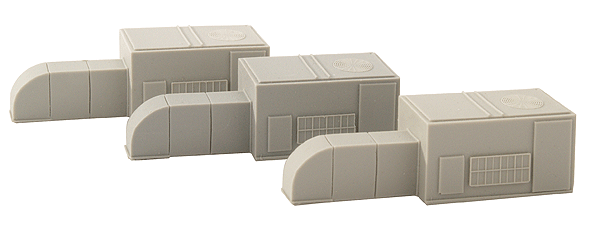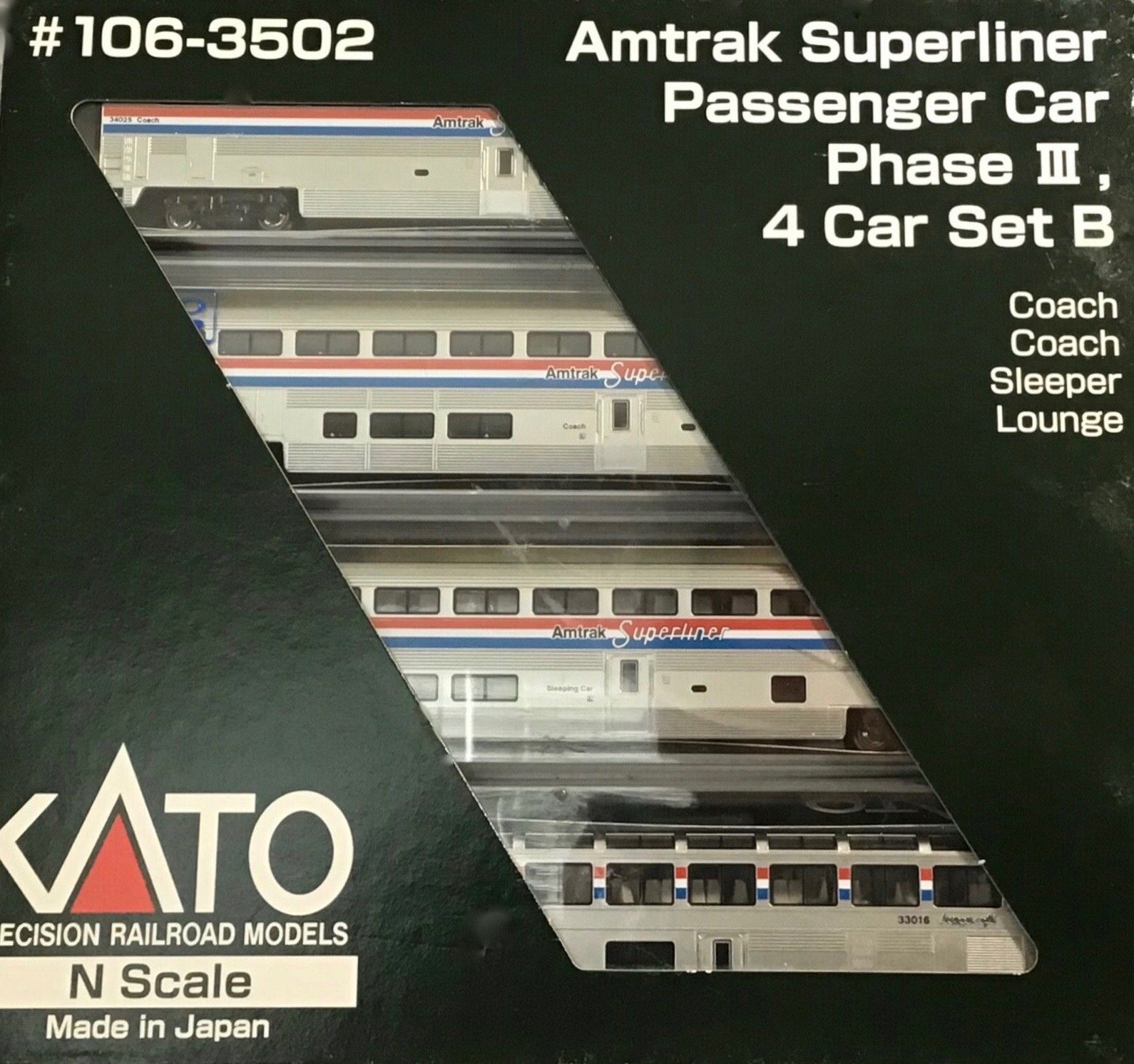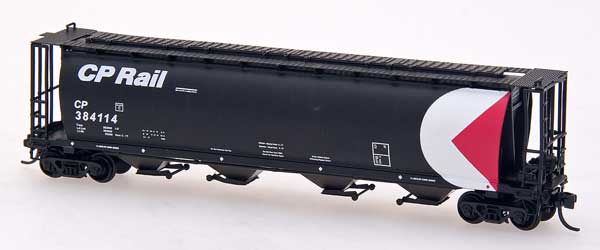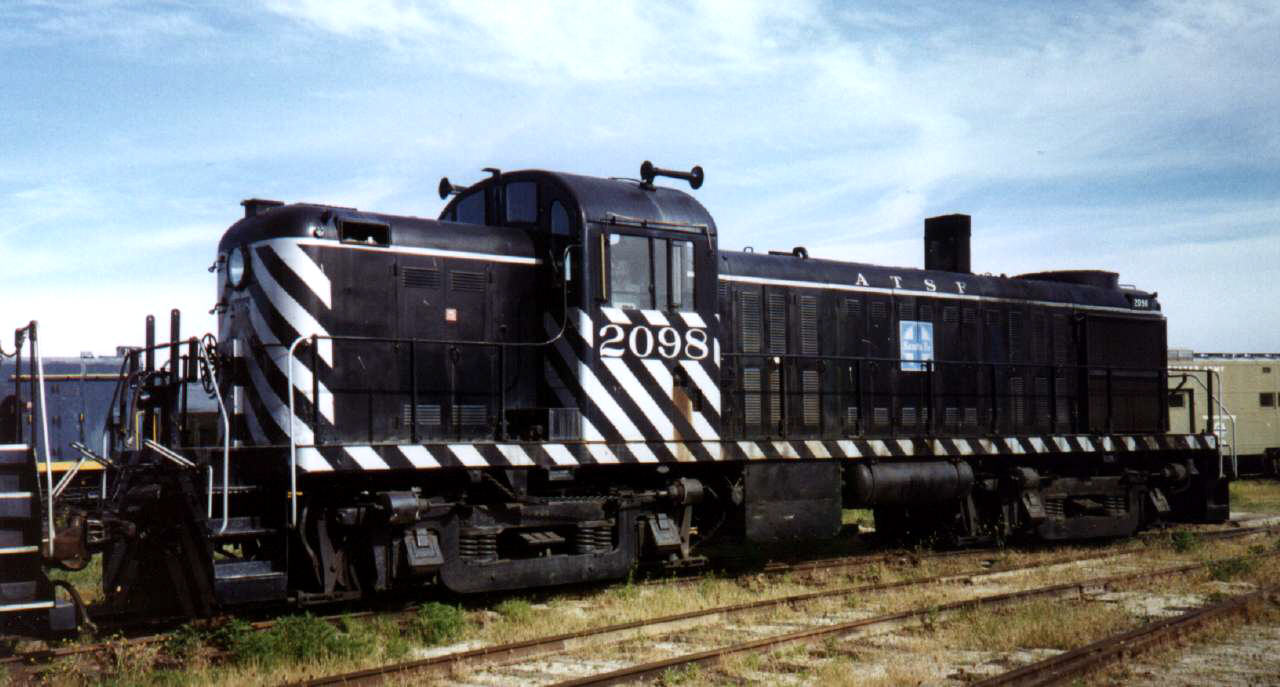Specific Item Information: MODEL FEATURES:
• Slow Speed Motor
• Golden-White LED s
• Directional lighting
• Dual brass flywheels
• Low-friction mechanism
• Dynamic brakes
• Factory-installed AccuMate® magnetic knuckle couplers
• Accurate painting and lettering
Model Information: First released in 2007. Subsequent releases in 2008, 2011 and in 2012 (with MTL couplers). A fifth release was announced in 2012, but eventually cancelled due to insufficient reservations.
Re-run under Atlas brand in 2019 after Atlas purchased the tooling from Walthers.
Features:
Re-run under Atlas brand in 2019 after Atlas purchased the tooling from Walthers.
Features:
- split-frame, all-metal, DCC-Friendly chassis,
- 5-pole skew-wound "scale speed" motor, with dual flywheels,
- low-friction drive,
- bi-directional LED lighting,
- all-wheel drive and pickup (no traction tires),
- blackened, low-profile wheels,
- body-mounted Accumate couplers.
DCC Information: Contrary to the above review, due to the amount of effort required to install a decoder, we elected to classify this as DCC-Friendly.
Accepts the following plug-in decoders (non-sound), but requires a full disassembly of the locomotives, and proper isolation of the motor from the chassis with insulating tape:
- Digitrax DN163K2: 1 Amp N Scale Mobile Decoder for Kato N scale SD80/90MAC Series, RSC2, RS2. See installation tips on Digitrax website.
- TCS K2D4: N-scale drop-in decoder designed for Kato RS2/RSC2, SD80/SD90MAC and Life-Like/Walthers RS2, GP18 locomotives. See installation tips on TCS website.
The Atlas version of 2019 comes either with a factory-installed DCC decoder or in DC version.
Accepts the following plug-in decoders (non-sound), but requires a full disassembly of the locomotives, and proper isolation of the motor from the chassis with insulating tape:
- Digitrax DN163K2: 1 Amp N Scale Mobile Decoder for Kato N scale SD80/90MAC Series, RSC2, RS2. See installation tips on Digitrax website.
- TCS K2D4: N-scale drop-in decoder designed for Kato RS2/RSC2, SD80/SD90MAC and Life-Like/Walthers RS2, GP18 locomotives. See installation tips on TCS website.
The Atlas version of 2019 comes either with a factory-installed DCC decoder or in DC version.
Prototype History: The ALCO RS-2 is a 1,500–1,600 horsepower (1,100–1,200 kW) B-B road switcher diesel-electric locomotive built by the American Locomotive Company (ALCO) from 1946 to 1950. ALCO introduced the model after World War II as an improvement on the ALCO RS-1. The locomotive was one of several road switchers in a crowded market, including the Baldwin DRS-4-4-1500, EMD GP7, and FM H-15-44. ALCO discontinued the RS-2 in 1950 in favor of the ALCO RS-3. Several examples have been preserved.
383 locomotives were produced — 374 by the American Locomotive Company, and 9 by Montreal Locomotive Works in Canada. Eight of the ALCO RS-2s were exported to Canada. The RS-2 has a single, 12 cylinder, model 244B engine, developing 1,500 horsepower (1,100 kW). Thirty-one locomotives built by Alco between February and May 1950 with the 12 cylinder 244C 1,600 horsepower (1,200 kW) engine.
From Wikipedia
Read more on American-Rails.com
383 locomotives were produced — 374 by the American Locomotive Company, and 9 by Montreal Locomotive Works in Canada. Eight of the ALCO RS-2s were exported to Canada. The RS-2 has a single, 12 cylinder, model 244B engine, developing 1,500 horsepower (1,100 kW). Thirty-one locomotives built by Alco between February and May 1950 with the 12 cylinder 244C 1,600 horsepower (1,200 kW) engine.
From Wikipedia
Read more on American-Rails.com
Road Name History: The New York Central Railroad (reporting mark NYC), known simply as the New York Central in its publicity, was a railroad operating in the Northeastern United States. Headquartered in New York City, the railroad served most of the Northeast, including extensive trackage in the states of New York, Pennsylvania, Ohio, Michigan, Indiana, Illinois, and Massachusetts, plus additional trackage in the Canadian provinces of Ontario and Quebec.
The railroad primarily connected greater New York and Boston in the east with Chicago and St.Louis in the midwest along with the intermediate cities of Albany, Buffalo, Cleveland, Cincinnati, and Detroit. NYC's Grand Central Terminal in New York City is one of its best known extant landmarks.
1853 company formation: Albany industrialist and Mohawk Valley Railroad owner Erastus Corning managed to unite ten railroads together into one system, and on March 17, 1853 executives and stockholders of each company agreed to merge. The merger was approved by the state legislature on April 2, and by May 17, 1853 the New York Central Railroad was formed.
In 1867 Vanderbilt acquired control of the Albany to Buffalo running NYC. On November 1, 1869 he merged the NYC with his Hudson River Railroad into the New York Central and Hudson River Railroad. Vanderbilt's other lines were operated as part of the NYC.
In 1914, the operations of eleven subsidiaries were merged with the New York Central & Hudson River Railroad, re-forming the New York Central Railroad. From the beginning of the merge, the railroad was publicly referred to as the New York Central Lines. In the summer of 1935, the identification was changed to the New York Central System.
In 1968 the NYC merged with its former rival, the Pennsylvania Railroad, to form Penn Central (the New York, New Haven and Hartford Railroad joined in 1969). That company went bankrupt in 1970 and was taken over by the federal government and merged into Conrail in 1976. Conrail was broken up in 1998, and portions of its system was transferred to the newly formed New York Central Lines LLC, a subsidiary leased to and eventually absorbed by CSX and Norfolk Southern. Those companies' lines included the original New York Central main line, but outside that area it included lines that were never part of the New York Central system. CSX was able to take one of the most important main lines in the nation, which runs from New York City and Boston to Cleveland, Ohio, as part of the Water Level Route, while Norfolk Southern gained the Cleveland, Ohio to Chicago, Illinois portion of the line called the Chicago line.
At the end of 1925, the New York Central System operated 11,584 miles (18,643 km) of road and 26,395 miles (42,479 km) of track; at the end of 1967 the mileages were 9,696 miles (15,604 km) and 18,454 miles (29,699 km).
Read more on Wikipedia.
The railroad primarily connected greater New York and Boston in the east with Chicago and St.Louis in the midwest along with the intermediate cities of Albany, Buffalo, Cleveland, Cincinnati, and Detroit. NYC's Grand Central Terminal in New York City is one of its best known extant landmarks.
1853 company formation: Albany industrialist and Mohawk Valley Railroad owner Erastus Corning managed to unite ten railroads together into one system, and on March 17, 1853 executives and stockholders of each company agreed to merge. The merger was approved by the state legislature on April 2, and by May 17, 1853 the New York Central Railroad was formed.
In 1867 Vanderbilt acquired control of the Albany to Buffalo running NYC. On November 1, 1869 he merged the NYC with his Hudson River Railroad into the New York Central and Hudson River Railroad. Vanderbilt's other lines were operated as part of the NYC.
In 1914, the operations of eleven subsidiaries were merged with the New York Central & Hudson River Railroad, re-forming the New York Central Railroad. From the beginning of the merge, the railroad was publicly referred to as the New York Central Lines. In the summer of 1935, the identification was changed to the New York Central System.
In 1968 the NYC merged with its former rival, the Pennsylvania Railroad, to form Penn Central (the New York, New Haven and Hartford Railroad joined in 1969). That company went bankrupt in 1970 and was taken over by the federal government and merged into Conrail in 1976. Conrail was broken up in 1998, and portions of its system was transferred to the newly formed New York Central Lines LLC, a subsidiary leased to and eventually absorbed by CSX and Norfolk Southern. Those companies' lines included the original New York Central main line, but outside that area it included lines that were never part of the New York Central system. CSX was able to take one of the most important main lines in the nation, which runs from New York City and Boston to Cleveland, Ohio, as part of the Water Level Route, while Norfolk Southern gained the Cleveland, Ohio to Chicago, Illinois portion of the line called the Chicago line.
At the end of 1925, the New York Central System operated 11,584 miles (18,643 km) of road and 26,395 miles (42,479 km) of track; at the end of 1967 the mileages were 9,696 miles (15,604 km) and 18,454 miles (29,699 km).
Read more on Wikipedia.
Brand/Importer Information: In 1924 Stephan Schaffan, Sr. founded the Atlas Tool Company in Newark, New Jersey. In 1933 his son, Stephan Schaffan, Jr., came to work for his father at the age of sixteen. Steve Jr. built model airplanes as a hobby and frequented a local hobby shop. Being an enterprising young man, he would often ask the owner if there was anything he could do to earn some extra spending money. Tired of listening to his requests, the hobby-store owner threw some model railroad track parts his way and said, "Here, see if you can improve on this".
In those days, railroad modelers had to assemble and build everything from scratch. Steve Jr. created a "switch kit" which sold so well, that the entire family worked on them in the basement at night, while doing business as usual in the machine shop during the day.
Subsequently, Steve Jr. engineered the stapling of rail to fiber track, along with inventing the first practical rail joiner and pre-assembled turnouts and flexible track. All of these products, and more, helped to popularize model railroading and assisted in the creation of a mass-market hobby. The budding entrepreneur quickly outgrew the limitations of a basement and small garage operation. Realizing they could actually make a living selling track and related products, Steve and his father had the first factory built in Hillside, New Jersey at 413 Florence Avenue in 1947. On September 30, 1949, the Atlas Tool Company was officially incorporated as a New Jersey company.
In 1985, Steve was honored posthumously for his inventions by the Model Railroad Industry Association and was inducted into the Model Railroad Industry Hall of Fame in Baltimore, Maryland. In addition, Steve was nominated and entered into the National Model Railroad Association Pioneers of Model Railroading in 1995.
In the early 1990s, the Atlas Tool Company changed its name to Atlas Model Railroad Company, Inc.
In those days, railroad modelers had to assemble and build everything from scratch. Steve Jr. created a "switch kit" which sold so well, that the entire family worked on them in the basement at night, while doing business as usual in the machine shop during the day.
Subsequently, Steve Jr. engineered the stapling of rail to fiber track, along with inventing the first practical rail joiner and pre-assembled turnouts and flexible track. All of these products, and more, helped to popularize model railroading and assisted in the creation of a mass-market hobby. The budding entrepreneur quickly outgrew the limitations of a basement and small garage operation. Realizing they could actually make a living selling track and related products, Steve and his father had the first factory built in Hillside, New Jersey at 413 Florence Avenue in 1947. On September 30, 1949, the Atlas Tool Company was officially incorporated as a New Jersey company.
In 1985, Steve was honored posthumously for his inventions by the Model Railroad Industry Association and was inducted into the Model Railroad Industry Hall of Fame in Baltimore, Maryland. In addition, Steve was nominated and entered into the National Model Railroad Association Pioneers of Model Railroading in 1995.
In the early 1990s, the Atlas Tool Company changed its name to Atlas Model Railroad Company, Inc.
Item created by: CNW400 on 2019-03-21 17:44:03. Last edited by CNW400 on 2021-01-13 12:39:36
If you see errors or missing data in this entry, please feel free to log in and edit it. Anyone with a Gmail account can log in instantly.
If you see errors or missing data in this entry, please feel free to log in and edit it. Anyone with a Gmail account can log in instantly.


